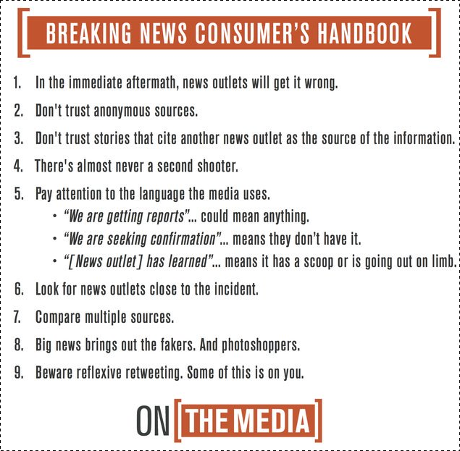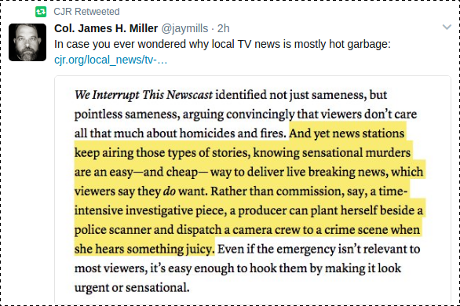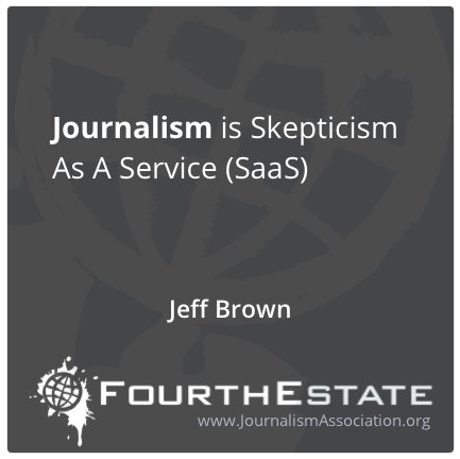The Columbia Journalism Review (CJR) normally has great headlines but the editors missed a serious opportunity with: Megyn Kelly fiasco is one more instance of far right outmaneuvering media by Becca Lewis and Alice Marwick.
Lewis and Marwick capture the essential facts and then lose their key insights in order to portray “the media” (whoever that is) as a victim of far right trolls.
…
Indeed, research suggests that even debunking falsehoods can reinforce and amplify them. In addition, if a media outlet declines to cover a story that has widely circulated in the far-right and mainstream conservative press, it is accused of lying and promoting a liberal agenda. Far-right subcultures are able to exploit this, using the media to spread ideas and target potential new recruits.
A number of factors make the mainstream media susceptible to manipulation from the far-right. The cost-cutting measures instituted by traditional newspapers since the 1990s have resulted in less fact-checking and investigative reporting. At the same time, there is a constant need for novelty to fill a 24/7 news cycle driven by cable networks and social media. Many of those outlets have benefited from the new and increased partisanship in the country, meaning there is now more incentive to address memes and half-truths, even if it’s only to shoot them down.
…
Did you catch them? The key insights/phrases?
- “…declines to cover a story that has widely circulated…it is accused of lying and promoting a liberal agenda…”
- “…less fact-checking and investigative reporting…”
- “…constant need for novelty to fill a 24/7 news cycle driven by cable networks and social media…”
Declining to Cover a Story
“Far-right subcultures” don’t exploit “the media” with just any stories, they are “…widely circulated…” stories. That is “the media” is being exploited over stories it carries out of fear of losing click-through advertising revenue. If a story is “widely circulated,” it attracts reader interest, page-views, click-throughs and hence, is news.
Less Fact-Checking and Investigative Reporting
Lewis and Marwick report the decline in fact-checking and investigative reporting as fact but don’t connect it to “the media” carrying stories promoted by “far-right subcultures.” Even if fact-checking and investigative reporting were available in abundance, for every story, given enough public interest (read “…widely circulated…”), is any editor going to decline a story of wide spread interest? (BTW, who chose to reduce fact-checking and investigative reporting? It wasn’t “far-right subcultures” choosing for “the media.”
Constant Need for Novelty
The “…constant need for novelty…” and its relationship to producing income for “the media” is best captured by the following dialogue from Santa Claus (1985)
…
How can I tell all the people
about my something special?
Advertise. Advertise?
How do I do that?
In my line,
television works best.
Oh, I know! Those little picture
box thingies? Can we get on those?
With enough money, a horse in a
hoop skirt can get on one of those.
…
In the context of Lewis and Marwick, far-right subculture news is the “horse in a hoop skirt” of the dialogue. It’s a “horse in a hoop skirt” that is generating page-views and click-through rates.
The Missed Headline
I’m partial to my headline but the CJR aims at a more literary audience, I would suggest:
The Media and Far Right Trolls – Imitating Alessandro and Napoleone
Alessandro and Napoleone, currently residents of Hell, are described in Canto 32 of the Inferno (Dante, Ciardi translation) as follows:
When I had stared about me, I looked down
and at my feet I saw two clamped together
so tightly that the hair of their heads had grown
together, “Who are you,” I said, “who lie
so tightly breast to breast?” They strained their necks
and when they had raised their heads as if to reply,
the tears their eyes had managed to contain
up to that time gushed out, and the cold froze them
between the lids, sealing them shut again
tighter than any clamp grips wood to wood,
and mad with pain, they fell to butting heads
like billy-goats in a sudden savage mood.
“The media” now reports its “butting heads” with “far-right subcultures,” generating more noise, in addition to reports of non-fact-checked but click-stream revenue producing right-wing fantasies.



